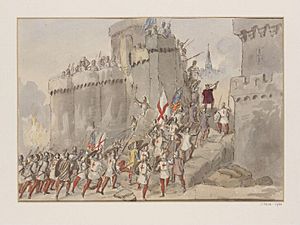William de Grenlay facts for kids
Quick facts for kids
Sir William de Grenlay
|
|
|---|---|
| Lord of Bordeshale | |

Coat of arms of Sir William de Grenlay
|
|
| Born | c. 1350s Edgbaston, Warwickshire, England |
| Died | 1415 (aged ~65) Harfleur, Normandy, France |
| Cause of death | Slain in battle |
| Family | de Grenlay (Grindlay) |
| Occupation | Soldier |
| Military career | |
| Allegiance | |
| Service/ |
English Army |
| Years of service | c. 1372 - 1415 |
| Rank | Knight; Man-at-Arms |
| Battles/wars | Hundred Years' War
|
| Relations |
|
Sir William de Grenlay (also known as Greneleye or Greenlee) was an English knight and landowner. He lived a long time ago, from around the 1350s until 1415. Sir William came from Edgbaston, Warwickshire, England. He was a brave soldier who fought in many battles during a very long conflict called the Hundred Years' War.
Contents
Who Was Sir William de Grenlay?
Family History
William was part of the de Grenlay family, who were important landowners in England. They were known for being soldiers and helping to manage lands. The family had been around for a long time, even before the Norman Conquest in 1066. They owned land in places like Warwickshire, Staffordshire, and Nottinghamshire.
The de Grenlay family's main lands were around a place called Bordeshale, which is now Balsall Heath. This made them important to powerful lords like the Barons of Dudley and the Earls of Warwick. Even after the Norman Conquest, William's family was allowed to keep their lands. They promised to be loyal to the new rulers in return for holding their ancestral estates.
Sir William's Military Adventures
Fighting in Brittany
In 1372, William prepared to go to war. He signed special papers called "Letters of Protection and Attorney." These papers were like a promise that his property and money would be safe while he was away fighting. This was common for knights and important soldiers.
In July 1372, William sailed to Brittany with a powerful lord named John Neville, 3rd Baron Neville. Neville was a royal ambassador, meaning he was sent by the king to make an alliance. William was part of Neville's personal group of soldiers, protecting him and the other ambassadors on their journey through northern France. After this trip, William returned safely to England.
The Great Chevauchée
A year later, in 1373, William signed more protection papers. This time, he joined Thomas Beauchamp, 12th Earl of Warwick, for more battles in France. He went with Beauchamp on a huge military march called the "Great Chevauchée." This was led by John of Gaunt, a son of the English king.
William rode with the army from Calais all the way to Bordeaux. This was a very long and difficult journey, about 900 kilometers (560 miles). The goal was to help a region called Aquitaine, but the mission wasn't successful. Despite the challenges, William survived this long raid and returned home in 1374. He was one of the few knights known by name who took part in this famous march.
The Siege of Harfleur
In the summer of 1415, William, who was about 65 years old, went back to war. This was the start of a new part of the Hundred Years' War. Even at his age, William was a very experienced soldier and a "Knight of the Royal Guard," like a royal bodyguard. He sailed with King Henry V and his army across the English Channel to France.
Other members of his family also joined the campaign. His cousin, John de Grenlay, fought at the siege and stayed in Harfleur afterward. Another William de Grenlay, from a different part of the family, fought at both Harfleur and the famous Battle of Agincourt.
During the final attack on Harfleur, Sir William and his soldiers joined the fight to capture the town's defenses. He bravely stormed a broken part of the walls with other leaders. Sadly, during the intense fighting to take the Leure fortress gateway, Sir William was badly wounded and died. His soldiers were able to get his body and his flag back after the outer walls were captured.
A Hero's Burial
After the siege, Sir William was buried where he fell, on the sloped ground outside the fortress. An oak tree was planted on his grave. King Henry V praised Sir William for his bravery. As a special honor, his family was allowed to add a green mound and an oak plant to their coat of arms. This oak tree became an important symbol for his family.
See also
- Grindlay family
- List of family seats of English nobility
Images for kids



